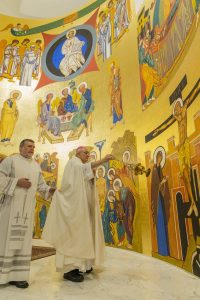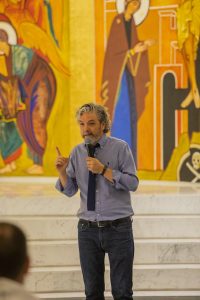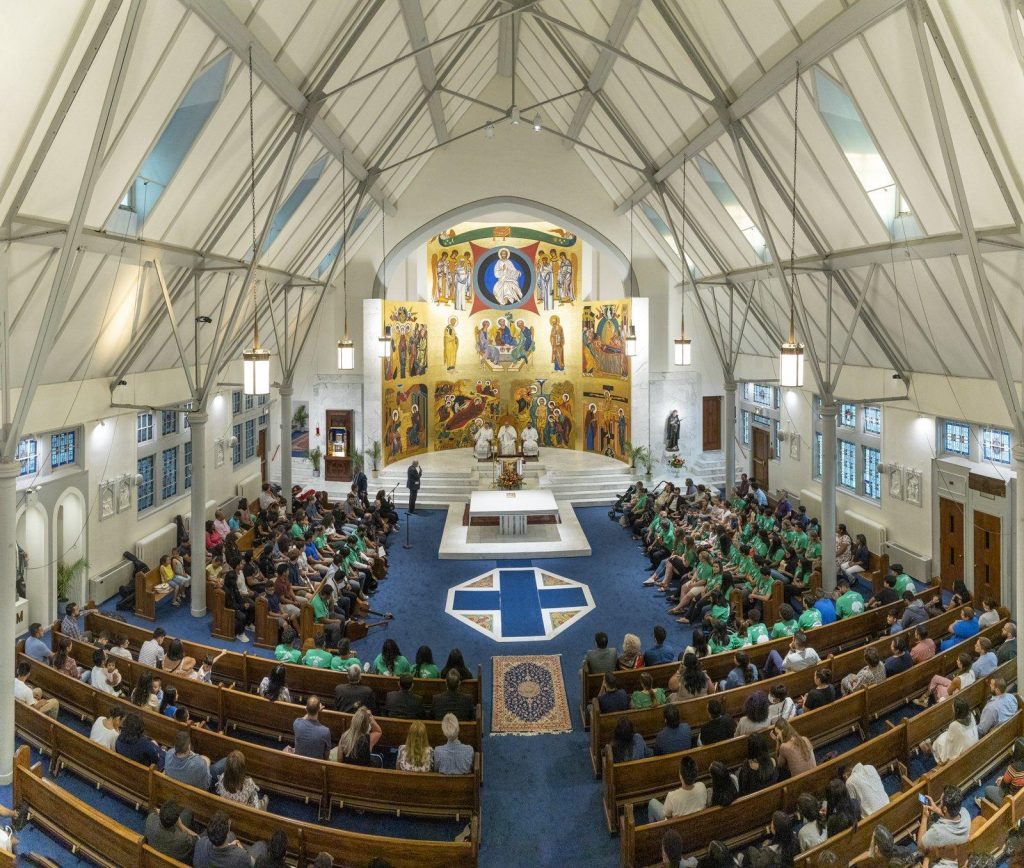From the outside, St. Gabriel of the Sorrowful Mother Catholic Church blends well with the drab brick buildings that line Astoria Boulevard down the road from New York’s LaGuardia Airport.
Inside, however, something more striking is welcoming parishioners back after the worst of the COVID-19 pandemic: a transformed interior with a mission of its own.
The most stunning piece is a 35-foot-by-45-foot painted altarpiece on a new semicircular apse, showcasing some of the most important mysteries of salvation.
Bishop Nicholas DiMarzio of Brooklyn, New York, visited the parish in the East Elmhurst area of the borough of Queens July 28 to bless the altarpiece.
“When we see these beautiful images behind us, they are the window into heaven. They teach us what is to come: the glory of heaven, the mystery of heaven,” Bishop DiMarzio said during an evening vespers service.
The bishop assured parishioners that, with the passing of the years, as they learn and understand more about each piece that populates the mural, they will find more features that speak to them directly about God.
“You will find your special spot here, where you will encounter God, where you will have a window into what heaven is like,” he said.

Parishioners said the mural’s blessing marked the culmination of late pastor Father Gioacchino Basile’s dream for St. Gabriel, that of a parish that could evangelize through beauty.
A native of Calabria, Italy, Father Basile, arrived as pastor in 2008. He believed a renovated space with a modern aesthetic could help draw people who might otherwise have little interest in the Catholic faith, particularly young people.
Father Basile, while already battling several health problems, contracted the coronavirus in the early days of the pandemic. He died April 4, 2020, at age 60 after being hospitalized.
Father Nicholas Apollonio, 37, a Brooklyn diocesan priest who also is from Italy, became parish administrator. With the church closed indefinitely, he saw an opportunity to continue the transformation that Father Basile had begun.
Over the next few months the church floor was covered in blue carpeting, a semicircular apse was built in the sanctuary and a new altar, ambo and floor — all made from white marble — were installed.
Some of the church’s benches were reoriented to face the ambo and the altar from the sides, a modification that Father Basile hoped would encourage greater liturgical participation in line with the recommendations of the Second Vatican Council.
When the church reopened its doors in July 2020, “the excitement was even greater” for parishioners returning after the monthslong closure, Father Apollonio said.
However, the renovation was not yet finished as the altarpiece remained.
Spanish contemporary artist David López Ribes was commissioned to paint the altarpiece. In 2012 Pope Benedict XVI awarded him the Pontifical Academies Prize for his contribution to the development of Christian humanism in contemporary society.
For more than two decades Lopez has collaborated with Kiko Argüello, a Spanish painter and co-founder of the Neocatechumenal Way, in the painting of churches and liturgical spaces worldwide as part of the development of a “new aesthetic” in the church.
“It has been an enormous grace for me to collaborate with Kiko, and for so many years,” said Lopez, who is currently developing projects in the U.S. with the support of the Vatican’s Pontifical Council for Culture, as well as the Louvre in Paris and The National Gallery in London.

The altarpiece’s composition is divided into three rows of icons, the first of which contains four scenes from Christ’s earthly life: Annunciation, Nativity, Baptism and Crucifixion. At the center of is an icon of the Trinity. Flanking it on the second row are the icons of the Ascension and the Dormition of the Virgin Mary, scenes intended to direct the viewer’s attention to heaven.
Directly above it, Christ Pantocrator is seen blessing and holding the book of life that reads: “Love your enemies, I am coming soon.”
While the paintings follow the tradition of Eastern iconography in their composition and design, they utilize styles and techniques drawn from the innovations of modern artists, including Matisse, Braque and Picasso, Lopez explained.
“The Western Church must today reflect on the aesthetics with which she wants to carry out her mission of evangelizing in the third millennium,” Lopez said.
The altarpiece was painted on stucco using mineral pigments bound with linseed oil and turpentine as well as gold leaf from Florence, Italy. The job took six months to complete with the help of a team that included Lopez’s wife and volunteers from as far as Italy, California and Hawaii.
As part of the renovation, an immersion baptismal font was installed at the center of the church, a modification intended to underscore the centrality of the sacrament of baptism with the Eucharist in Christian life.
“Extraordinary times call for extraordinary measures,” Father Apollonio explained. “Today, there is a need to put our baptism, our dying with Christ, at the center of everything, to help the faithful understand the role of our baptism in Christian life.”
Father Robert Sadlack, parochial vicar at St. Gabriel, said he has noticed how the renovation regularly draws new visitors, many from the New York City area but from elsewhere as well. Attendance at daily Mass now regularly surpasses 40 people, an increase from pre-pandemic times.
The priest said more than one parishioner has told him that whereas before they found themselves easily distracted during Mass, looking at the new icons now helps them pray and follow the liturgy better.
Father Apollonio also has found that the images are helpful as a catechetical tool for the children. “Kids tend to be very visual,” he said.
In a curious twist, the completion of the church’s renovation coincided with an unexpected announcement from Rome: the proclamation of a jubilee year by Pope Francis in February marking the 100th anniversary of the canonization of the parish’s namesake, St. Gabriel of the Sorrowful Mother, who was declared the patron saint of youth by Pope Benedict XV in 1920.
“(Father Basile) wanted to reach out to the young-adult community and to all the people that came to Mass, and he wanted to bring something new to them,” said parishioner Amador Bautista. “So, getting to know God through these icons can give us faith and help us reach eternal life.”

